Viola pedata L. var. flabellata D.Don
Common names:
Sandhills Birds'-foot Violet
Synonyms:
Viola pedata L. var. flabellata D.Don, in Sweet, Brit. fl. gard., ser. 2, 3: pl. 247. 1835-1837. TYPE: "It was introduced by Mr. Drummond from Georgia into the Botanic Garden, Glasgow, from whence it was sent to the Botanic Garden, Edinburgh, in 1832, and there it first produced a succession of flowers in the Greenhouse in the beginning of October, 1833." [Although it appears a single living collection was sent to the Glasgow Botanic Garden and part of that later to the Edinburgh Botanic Garden, no mention of herbarium specimens was made. The illustration in Sweet should be designated as the lectotype.]
Viola reidiae Cory, Field & Lab. 18: 155. 1950 [is this the same taxon?]. TYPE: USA, Texas, Newton Co., 2-1/2 miles southeast of the East Texas Baptist Encampment, which is about 4 miles west southwest of Newton, frequent in open pine woods, Scapes 1 or 2, up to 1.5 dm. high, upper leaves diamond-shaped and lower leaves ovate or broadly rounded, crenate, 19 Apr 1950, V. L. Cory 57217 (BRIT24164, JSTOR Global Plants image!).
Description:
Smaller leaf blades elliptical or suborbicular, shallowly apically toothed, largest leaf blades oblanceolate to obspatulate or sometimes somewhat rhombic in outline, apically toothed or incised. Other features are identical to the species.
Ecology:
Dry to xeric longleaf pine sandhills.
Distribution:
Sandhills region along the "fall line" in NC, SC and e. GA.
Rarity:
None.
Phenology:
Presumably same as the species.
Affinities:
Same as the species.
Hybrids:
None.
Comments:
McKinney and Russell (2002) and Little and McKinney (2015) recognized this regional endemic of the Sandhills region of the Carolinas and Georgia but applied the name var. ranunculifolia (Juss. ex Poir.) Ging. ex DC. The protologue, type material and herbarium specimens representative of that name do not adequately match the morphological extreme represented by var. flabellata and are not geographically restricted to the Sandhills region. It is likely that plants matching var. ranunculifolia have more than one origin, since individuals are occasionally observed in areas where var. flabellata and var. pedata commingle and are very likely hybrids, whereas other individuals are encountered from outside the range of var. flabellata (such as plants occasionally collected in the range of var. cuneatiloba) that appear to be an instance of leaf "developmental arrest" similar to that seen in a rare specimens of V. tripartita with shallowly lobed leaf blades (see comments under that species). Russell and Bowen (1960) studied a population with the leaf morphology of var. flabellata east of Rockingham, North Carolina (in the Sandhills region), comparing the anomalous plants with locally frequent var. pedata and adjacent V. primulifolia. They concluded that the unusual leaf variation could be due to hybridization between typical V. pedata and V. primulifolia. I have examined several herbarium sheets of var. flabellata with chasmogamous flowers taken across its Sandhills range and found them morphologically identical in rhizome and floral characteristics to typical V. pedata. Moreover, pollen stainability of var. flabellata and typical V. pedata were both nearly or fully 100%, not what one would expect from an interploidal hybrid. Two localities, in Arkansas and Texas (the type locality of V. reidiae Cory) are similar to var. flabellata in being unlobed and merely incised or toothed apically, but their leaf blades are somewhat differently shaped, and the plants grow outside the Sandhills region. They are anomalous and require further study. The name best applied to the present taxon is V. pedata var. flabellata, according to the illustration provided by Don in Sweet's catalog. However, the illustration of a plant from Georgia with some leaf blades exactly matching the Sandhills endemic taxon also bears other leaf blades resembling the "ranunuculifolia" phenotype, suggesting that the illustration was based on a hybrid between typical var. flabellata and var. pedata. The name is tentatively applied here.
Literature Cited:
Little, R. J., and L. E. McKinney. 2015. Violaceae. In Flora of North America: Cucurbitaceae to Droseraceae, 106. Oxford University Press, New York, NY.
McKinney, L. E., and N. H. Russell. 2002. Violaceae of the southeastern United States. Castanea 67: 369-379.
Russell, N. H., and W. Bowen. 1960. A hypothesis to account for unusual leaf variation in Viola pedata L. Proceedings of the Iowa Academy of Science 67: 189-194.
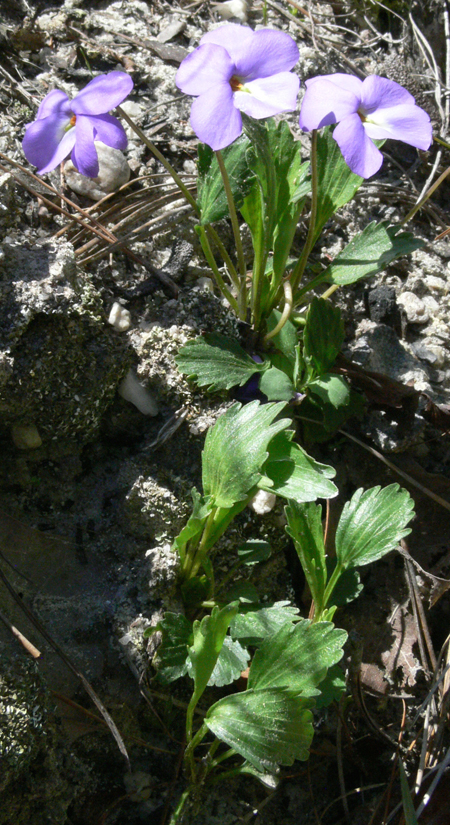
Chasmogamous flowering habit by Bruce Sorrie
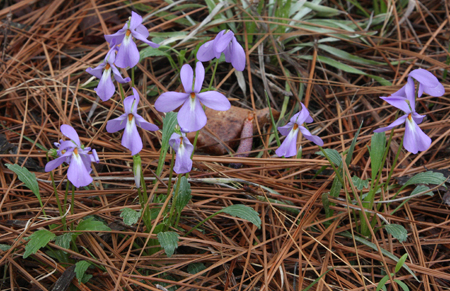
Chasmogamous flowering habit by Bruce Sorrie
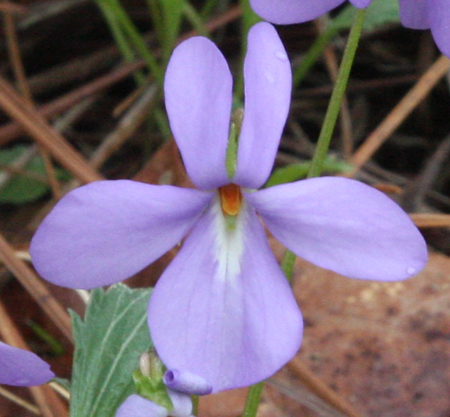
Chasmogamous flower front view by Bruce Sorrie
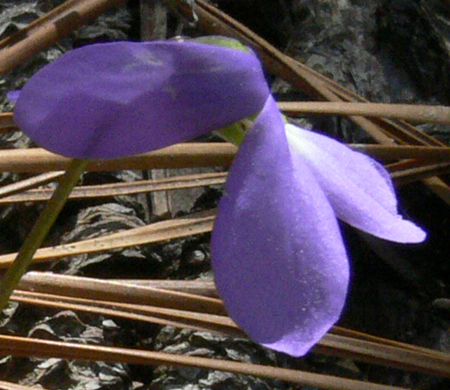
Chasmogamous flower profile view by Bruce Sorrie
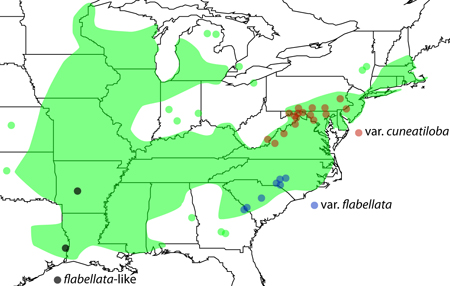
Map of varieties of V. pedata by Harvey Ballard, with var. pedata adapted from Russell (1965)